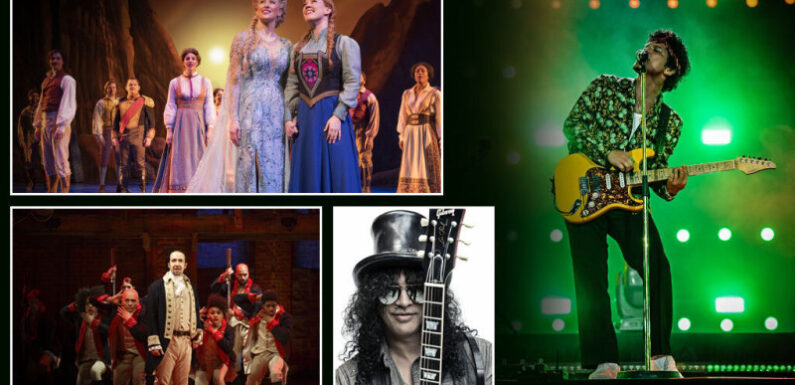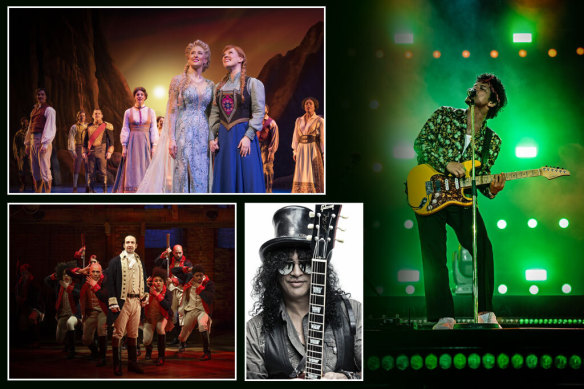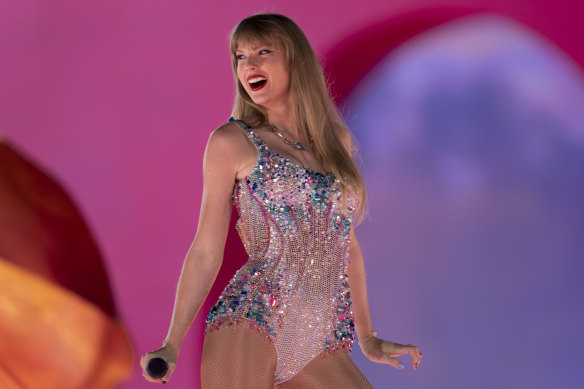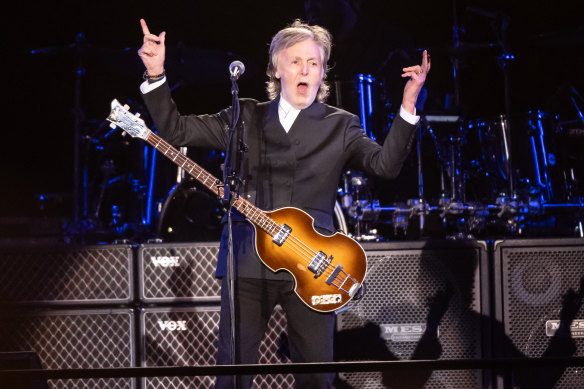
Save articles for later
Add articles to your saved list and come back to them any time.
Key points
- Some 24 million tickets were issued in 2022 for live shows across Australia, according to peak lobby group Live Performance Australia’s annual data.
- Ticket revenue topped $2 billion, up almost 200 per cent on the previous year, a period marked by pandemic lockdowns.
- Contemporary music and festivals accounted for about 50 per cent show revenue and 42 per cent of all attendees off as global tours by acts such as Guns N’ Roses and Bruno Mars resumed.
- Musical theatre had its biggest year since data has been collected, with shows such as Hamilton, Frozen and Phantom of the Opera driving the stage business.
- Average concert ticket prices leapt 53 per cent but stopped short of pre-pandemic peaks.
Australian audiences flocked to concerts, festivals and theatres in near-record numbers after the end of lockdowns with fans paying up to 50 per cent more last year to see their favourite bands, comedy acts and Broadway musical hits.
Guns N’ Roses, Bruno Mars and Billie Eilish, Broadway hits Hamilton and Frozen and the return of Splendour in the Grass, Bluesfest, Spilt Milk and Listen Out festivals led a robust recovery in the live performance sector, which all but shut down in 2021.
Global acts have led the post-pandemic recovery of Australia’s live music sector.Credit: Graphics
More than 24 million people turned out for live shows post COVID, spending $2 billion on tickets, the second-highest figures since Live Performance Australia (LPA) began collecting ticketing data in 2004.
But the live performance sector says the growth belies crippling production and touring costs, as well as rising cost-of-living pressures that are increasingly seeing audiences buy late and more selectively.
Average ticket prices rose from $69 to $90, an increase of 30 per cent in one year, but still below pre-pandemic peaks.
Concert tickets rose 53 per cent to an average of $87, off a low base when the sector had hit rock bottom and virtually shuttered.
Festival-goers forked out the most for tickets, an average of $169.53 compared to $128 for a night of musical theatre, where Hamilton, Phantom of the Opera, Frozen and Rodgers and Hammerstein’s Cinderella were the biggest draws.
Classical music, too, recorded its highest-ever ticket sales of $88.9 million, off the back of tours by Andrea Bocelli, Croatian duo 2CELLOS, and Iraqi singer and composer Kadim Al Sahir.
LPA said the sector was aware of the limited ability of consumers to absorb soaring costs of production and touring, one of many lingering impacts of COVID. The cost of transporting shows between Melbourne and Sydney rose 40 per cent in the last year alone.
Taylor Swift tours Australia February 2024 and is likely to spur peak growth in ticket sales and attendance.Credit: AP
“You can’t keep putting ticket prices up especially in a cost-of-living crisis,” LPA’s chief executive Evelyn Richardson said. “People might be still seeing shows, but they are being more discerning, especially families,” she said. “We are sensitive to the ability of audiences to pay.”
LPA’s report has served as a barometer for the health of Australia’s live performance sector since it began collating ticketing data from ticketing companies, venues, event promoters and cultural institutions 19 years ago.
After collectively spending more than 200 days under lockdowns in 2021, it was the states of Victoria and NSW that led the resurgence in attendances and ticket revenue in 2022.
Victoria powered back after COVID to eclipse NSW – 7.8 million attendees versus 7.2 million – as home to the most enthusiastic, big-spending fans.
In the two states, contemporary music was the most widely watched live entertainment. In the smaller market of Queensland, 3.7 million people paid to see a live performance, representing less than half the year-on-year audience growth of NSW, and one third that of Victoria.
Get Back, down under: Paul McCartney packed out two nights at Sydney’s Allianz Stadium in October.Credit: Wolter Peeters
On the back of pent-up demand and rescheduled global tours, ticket revenue tripled for contemporary music, but fell short of the peak of 2018.
Musical theatre recorded its biggest year since data was recorded and this year is expected to supersede that.
A record seven shows played on Sydney stages in September, the genre’s surging popularity buoyed by a new generation of young superfans.
This summer, east coast concert tours by Paul McCartney, Foo Fighters, Kiss and Taylor Swift are expected to drive a bumper outdoor stadium concert season, with rumours Beyonce will bring her Renaissance tour to Australia next year.
But the strong figures mask struggles within the sector, Richardson said.
“Despite all that, we know parts of our industry, particularly small-to-mediums and not-for-profits, are still being impacted by COVID, and that plays out in crippling skill shortages, huge production costs and changing audience behaviours.
“People are buying later and now are grappling cost-of-living pressures. Companies don’t have reserves and no longer are eligible for COVID support. We are still in pain.”
Four million Australians saw a musical theatre show, more than turned up to see a National Rugby League game, LPA said. Drama theatre attracted bigger audiences than the A-League.
Attendances at the ballet, dance and comedy were strong but have not yet returned to pre-pandemic peaks. Circus and physical theatre recorded a 10 per cent decline in audiences.
Find out the next TV, streaming series and movies to add to your must-sees. Get The Watchlist delivered every Thursday.
Most Viewed in Culture
From our partners
Source: Read Full Article


